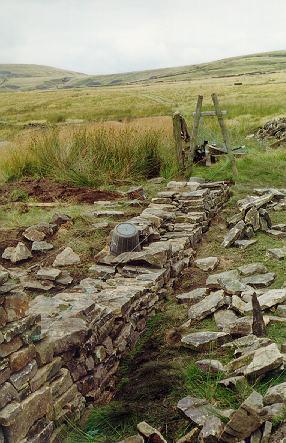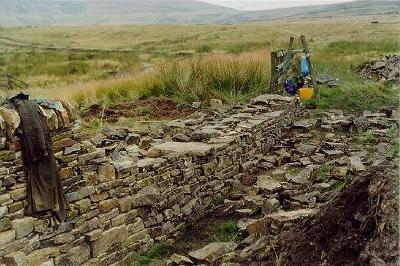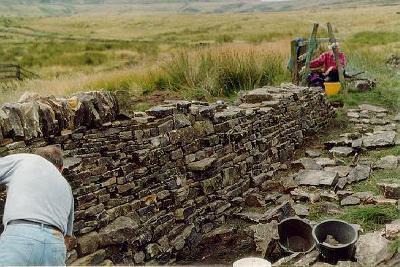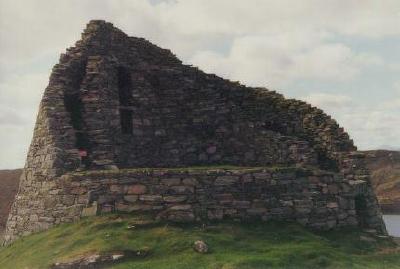I think that dry stone walls are one of the most charming features of the British countryside. These are walls made completely without cement or mortar, just using the skill and eye of the waller in placing the rocks so that their own weight binds them together. R. and I were in the UK for a year or so a while back, and in our travels around Britain we would often stop to take photos and look at how they might have been constructed. Most of the ones you see in the North of England are up to 250 years old dating from the time of the enclosures (in the South people grew hedges instead). But there are other examples that are much much older still. It is a very old craft.
Building a wall

In fact, I liked walls so much I decided to go on a walling course not long before I left the UK in 1997. As it was near the end of the summer I had a few problems finding one that suited; but eventually one Friday night I ended up in Littleborough (near Manchester).
The next morning I found my way up onto the moor and the site of the course (using a trusty OS Map, of course). The tutor explained the basics. I found out the rather depressing news that the standard Pennine Wall, the kind we would be building over the next two days, uses approximately a tonne of rock per metre of length. As I had been doing a typical soft southerner’s office job in London, I knew at once that I was going to have an interesting time.
Above (Dry Stone Wall in progress: 1) you can see the base laid; note the two parallel lines of stone.The Pennine Wall is built double, with some ‘through-stones’ later on.

You can now (Dry Stone Wall in progress: 2) clearly see the through-stones at this stage. These help to bind both sides of the wall together.

And now (Dry Stone Wall in progress: 3) you can see we’ve started putting the cope-stones in on the wall end closest to us. These lock together to (hopefully) stop stock from knocking the wall over. Plus they look good too.
It was much harder work than I expected, but it was good to see the results. I learnt quite a lot… but one of the biggest lessons was that I’m simply not built for moving tons of rock about professionally. I’d like to have a go in the back garden one day though (although maybe Wellington is not the best place for this).
Some interesting examples
R. and I lived in the UK for 18 months or so in 1996 and 1997. That’s when I became interested in Dry Stone Walls… and I would often take pictures when I could. Here are a few of the more interesting ones.
Tintagel, Cornwall, England, Easter 1997.

This is a brilliant example of a peculiarly Cornish style of walls - in slate areas this method had to be used as the slate doesn’t bear weight very well at right angles to its grain. So instead the weight is transferred down more with the grain than against it. Looks very good as well.
Ungeshader, Isle of Lewis, Scotland, May 1997.

This is a very good example of a skilled craftsperson’s work. Although the rock is of reasonably variable sizes and shapes (contrast this with the rock in the Littleborough pictures) whoever did this has managed to work with it to a beautiful result.
Doune Carloway, Isle of Lewis, Scotland, May 1997.

Now this really is a wonder; it’s the remains of an ancient fort. I later wrote up a diary of this particular trip, and this what I had to say about the broch:
“[It] is the best example surviving of many hundreds of such fortifications in Scotland’s north and west dating from around the first century AD and one theory suggests that the brochs were built to repel Roman slave raiders. It sits on a ridge overlooking the sea: it’s about 40 feet tall, and about 50 feet in diameter; the entrance is a very low doorway. It was extremely cunningly constructed: two tapered drystone walls, one inside the other, with flat supporting stones running through both walls arranged in a spiral pattern up the tower so that defenders could quickly climb to the top whilst inside the walls. It used to be about 40 feet tall right around, but now there’s only about half of it left, a large diagonal bite having been taken from it. The outer walls have a perfect and steep slope, with very few gaps for fingers. There’s a story about how the MacAuleys got revenge on a Morrison cattle-raiding party: a MacAuley climbed the outside of the broch using a pair of knives; in his teeth he held a burning torch. Once at the top he set fire to the thatched roof hiding the Morrison party and burnt them out.”
Loch Risay, Island of Great Bernera, Scotland, May 1997.

Well, I really can’t say enough about this. Within line of sight of the Carloway Broch over the water, I actually think that this is worth at least one Cathedral. It is definitely one of the most amazing things I’ve seen on my travels. Here’s the story from my diary again:
“While in the [Great Bernera] museum I had read of an enterprising Bernera man in the 1860s who engineered a solution to another local problem. In high summer the lobsters [Bernera’s main industry] were at their most plentiful around Bernera; but because of the warmth and the distance to market it was not worth trying to export them. Before leaving for Australia to make some money, he marked out a site beside a narrow bay of Loch Risay. When he returned five years later, he used his money to build a dry stone wall right across the bay, cutting it off from the sea. The tide was able to run through the stone wall, aerating the water, but anything within could not escape. Now, he could store the lobsters caught during the good weather of summer and sell them later when the market had picked up in the autumn. He could even supply them out of season, during the winter.”
The archetype of Scots canniness, eh?! So I decided to go and have a look - it took a bit to find, and a long walk around a deeply indented bay of the sea, but I got there eventually:
“The wall must have been 20 feet at its deepest and was a good three feet wide all along the top. Large flat stones had been placed on top, so I walked across into the middle: I had read in the museum of people mooring their boats here and kids fishing from it, so I guessed it would be fairly safe. The incoming tide was about 2 feet higher on the outside and gushing through the many small gaps in the wall. It was, without a doubt, the coolest man-made thing I had seen in the islands: I sat on the edge with my feet over the water and spared a thought for the builder. People said he was mad, wasting his money, that it would never work. But he laughed all the way to the bank, and the loch continued to be used right up into the 1930s. Besides being a canny businessman, he was also a scientist on the side: his lobsters started breeding in the loch, and his observations of their life-cycle were the first ever made.”
Maybe you had to be there. But I’m glad I went off the beaten track to find it. I often wonder if the English wallers know of its existence.
Note: this page was originally created for a university assignment (“Create a home page!") and has survived, in various incarnations, on my website ever since. The posting date is the date the assignment was due, back in 1998. Originally it was split over two smaller pages. This was all pre-digital, so at some point I need to find the original prints and re-scan them at a better resolution.